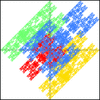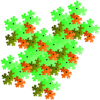issue contents
September 2020 issue

Cover illustration: Weavings, knots, links and related geometrical structures, such as polycatenanes, are currently of considerable interest in materials chemistry. In particular, reticular chemistry is concerned with the directed assembly of symmetrical frameworks from molecular components. The cover image shows isogonal torus knots (orange) and links (multicoloured), (p,q), for p = 9-12 [O'Keeffe & Treacy (2020). Acta Cryst. A76, 611-621]. There is one kind of vertex (isogonal) and two kinds of stick in each. These are shown for the maximum-girth embedding, where girth is defined as the ratio of the shortest stick separation divided by the longer stick length.
advances
scientific commentaries

topical reviews
 access
accessresearch papers
 access
accessfoundations
research papers
 access
access access
access access
access

 journal menu
journal menu




























